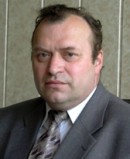
Plenary Lecture
Numerical Simulation of Non-linear Dynamics of Vibration Transport Machines with Independently Rotating Vibration Exciters

Professor Sergey A. Rumyantsev
The Department of Mechanics of Solids
Ural State University of Railway Transport
Ekaterinburg, Russia
E-mail: srumyantsev@math.usurt.ru
Abstract: Vibration transport machines (VTM) are intended for transporting and/or separating variable bulk materials. Most of these machines are constructed as solid bodies (working elements, WE) fixed on springs or by means of other elastic elements that enable their plane-parallel motion.
The motion of working elements is excited by special devices called vibration exciters (VE). VE act as unbalanced rotors driven by electric motors.
Most of researchers only explored synchronous motions of VE. We had stated the problem of transient dynamic processes researching. These processes are accompanying the start of the machine from its stand still until its reaching (or not reaching) stabled synchronous motion. This approach allows evaluating the time until synchronization and the type of connections between this time and various factors.
The research was carried out using the mathematical model of dynamics of vibration transport machines with random quantity of independently rotating vibration exciters. This mathematical model is based on numerical solution of differential equations system that describes the VTM dynamics as dynamics of Vibration Transport Machine – Driven Electric Motors electromechanical system in case of asynchronous motors with random quantity of poles’ pairs.
This mathematical model allows describing not only the influence of motors on non-stationary VTM dynamics, but also the influence of VTM dynamics on electromagnetic processes in the motor. It also makes it possible to calculate currents of the real three-phase motor.
The results of numerical simulation of one- and two-mass machines’ dynamics in cases of two, three, and four vibration exciters mounted on the lower mass of the VTM are represented in graphic form. We were interested in creating a two-mass machine, both masses of which are oscillating insignificantly while it is not loaded with bulk materials, but after loading it comes to a resonance and its vibration amplitude increases. We have found such parameters by which the abovementioned dynamics type appears. With the using of resonance it is possible to confine with moderate vibration amplitude of the lower mass which would lead to substantial electrical energy savings at the expense of decreasing drive motors capacity.
Brief Biography of the Speaker: Sergey Rumyantsev is a professor and head of the Department of Deformable Solids Mechanics at the Ural State University of Railway Transport, Ekaterinburg, Russia. He received his MSc at Faculty of Mathematics and Mechanics at Ural State University, Ekaterinburg. He has got his PhD (Candidate of Physical and Mathematical Sciences) at the Institute of Hydrodynamics, USSR’s Academy of Sciences, Novosibirsk. His Full Doctorship in Engineering Sciences he has got at the Institute for Problems in Mechanical Engineering, Russian Academy of Sciences, St. Petersburg. Presently he is teaching at the Ural State University of Railway Transport. His research activities include Computational Mechanics in particular non-linear problems of Thermoplasticiti and Mechanical Systems with big number of degrees of freedom. He has more than 60 publications in scientific journals and conferences. He has published a monograph entitled Dynamics of Transient Processes and Self-synchronization of Vibrational Machines Motions. Several PhD students are doing research under his supervision.